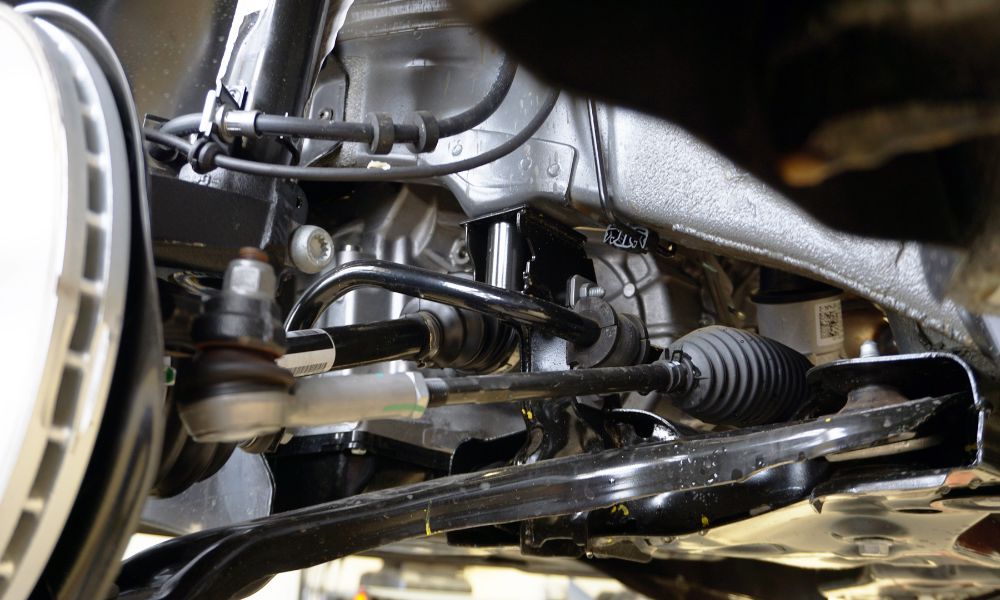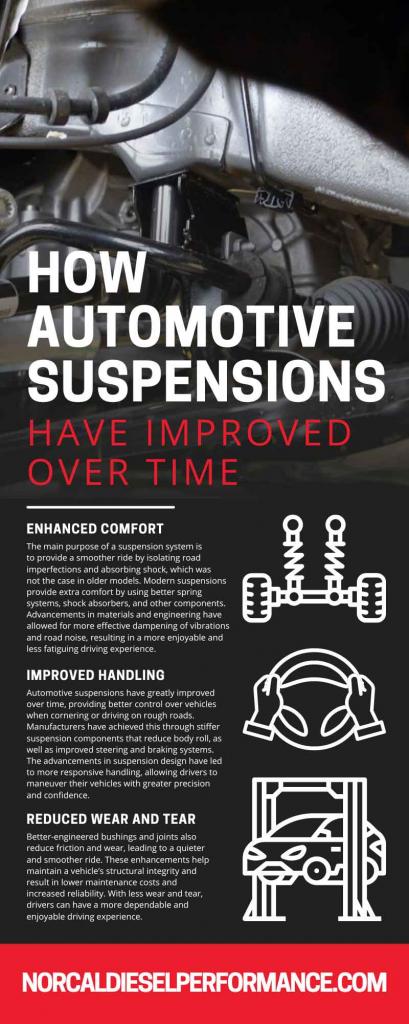


Automotive suspension systems have come a long way; they’re more efficient and reliable than ever before. Compared to the suspension systems of the past, modern iterations are smoother, safer, and provide a more comfortable driving experience. This is thanks to numerous advancements, including improvements in materials, design, and technology, that have played a crucial role in evolving these systems. If you’re curious just how much these systems have changed, we’ll give you some clear examples.
A suspension system is one of the biggest sources of comfort while driving. Their main purpose is to absorb shock and isolate road imperfections. Modern suspensions provide greater comfort over past models, thanks to better spring systems, shock absorbers, and other components. Advancements in both materials and engineering let suspension systems dampen vibrations and road noise.
As suspension systems have advanced, they have also improved their geometry and adjustability, which enables drivers to fine-tune their vehicles’ handling more. Drivers can find a balance between comfort and performance that suits their driving styles. We’ll go over handling improvements next.
Drivers have more control over their vehicles than ever before, especially when cornering or driving on tough roads. This is thanks to stiffer suspension components that reduce body roll. There have also been numerous improvements to steering and braking systems. Ultimately, these advancements have led to more responsive handling, so drivers can maneuver more accurately and with greater confidence.
Modern vehicles now have integrated advanced electronic systems. These systems give you features like traction control and electronic stability control. Manufacturers are constantly fine-tuning these systems too, doing things like distributing force safely across a vehicle’s wheels to further improve handling capability. Ultimately, these advancements make sure your vehicle has optimized grip and stability, even when you’re driving in less-than-ideal conditions.
By using better materials, you get less wear and tear on your suspension systems than you did in the past. Modern materials like high-strength steel and lightweight alloys are much more durable and longer-lasting.
Every part of the suspension has seen improvements in their materials, including bushing and joints. Bushings and joints now have less friction and wear on them as they operate, which makes driving generally quieter and smoother than before. For example, while bushings are traditionally rubber, they’re now also available in polyurethane. Polyurethane is a harder material than rubber, but it’s also resistant to a variety of factors, like chemicals or extreme temperatures, that might cause rubber bushings to break down faster.
All of these new materials have gone through better production techniques that improve their reliability. Processes like precision machining and computer-aided design make sure that every part of your suspension system has tighter tolerances and superior quality control. This means a reduced chance of component failure, and in the long-run you’re paying less maintenance costs and having shorter downtime from broken parts.
“Adaptability” refers to the level of customization drivers have over their suspension system. Drivers now have more customization than ever before. Using electronic or hydraulic components in your suspension system, you can adjust parameters like ride height, dampening stiffness, and spring rates. And all of this can be done with the touch of a button or turn of a dial.
Every driver who customizes their suspension is going to have their own tastes. Cars can be catered to different purposes too. For example, some drivers might customize their car for off-roading or racing on a track, while others just want a comfortable vehicle for daily driving. Whatever a driver wants out of their vehicle, improvements to adaptability will give them the best possible combination of comfort, handling, and stability.
Active suspension, air ride, and semi-active suspension systems have greatly improved vehicles’ performance since their introduction. These systems provide better handling and increased comfort when driving over bumps or uneven surfaces. Air ride suspensions use airbags, active suspensions employ sensors, and semi-active suspensions utilize adaptative dampers to find the ideal balance between handling and comfort.
These cutting-edge technologies enhance the driving experience while also contributing to improved safety through better contact between the tires and the road surface. This improved contact provides superior control and stability wherever you’re driving.
The importance of safety improvements in modern suspensions can’t be understated. All of these improvements –better materials, handling, and reliability– have greatly reduced the risk of accidents. Your automotive suspension absorbs impact from sudden movements or collisions, protecting the occupants inside. Modern suspension systems also make sure you have more consistent contact between the tires and the road, so there’s more stability. There’s also less risk of losing control during emergency maneuvers: sudden lane changes or hard braking.
Advanced suspension technologies also include active and semi-active systems that can automatically adjust settings as a response to changing road conditions. This means you’re less likely to skid or lose control while driving. A well-designed modern suspension will decrease the severity of impact during collision, lessening damage to the vehicle and lessening personal injury too.
The introduction of advanced suspension systems has helped improve fuel efficiency, as these systems reduce resistance caused by friction between the tires and the road. Lightweight materials, such as aluminum and carbon composites, in modern suspensions contribute to a reduction in overall vehicle weight, which further enhances fuel efficiency.
Optimized suspension geometry and alignment ensure tires maintain proper contact with the road surface, minimizing rolling resistance and promoting more efficient energy transfer. Some advanced suspensions, like active and semi-active systems, can also adapt to varying driving conditions, adjusting their settings for lower fuel consumption. Altogether, these advancements lead to cost savings for drivers of all vehicle makes and models.
The automotive suspension system has come a long way since its early development and has improved significantly in terms of comfort, handling, reliability, and fuel efficiency. While automotive suspensions have improved a lot over time, there are still some issues you may encounter with your suspension system. While that is not a fun situation to be in, we at Norcal Diesel Performance can help. We have all the Duramax suspension parts you need to repair and replace your system so you can keep your truck on the road for as long as possible.

You must login to post comments.